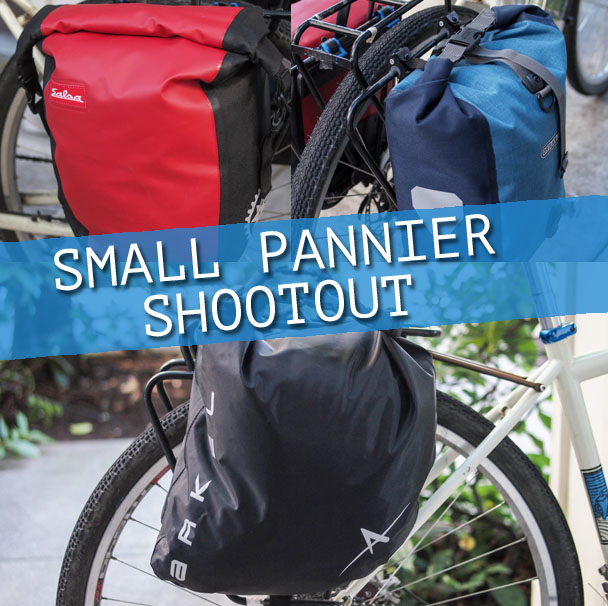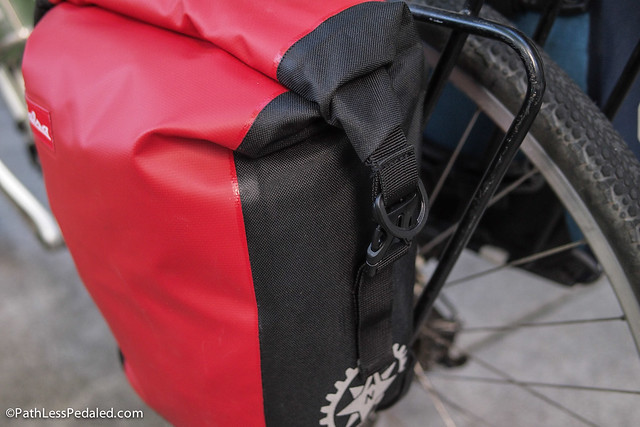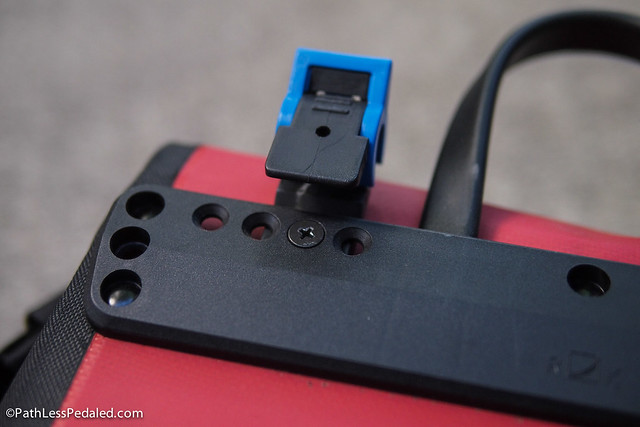Review: Small Pannier Shootout – Ortlieb Frontroller Plus vs Salsa Touring Pannier and Arkel Dry-Lites

Rackless bags are blowing up the bike touring / bikepacking internet. In the last few years, framebags (feedbags, seatbags, etc.,) have moved to the mainstream. With so many people going rackless, what is to become of the beautifully functional bicycle pannier? We think that panniers are here to stay, but are interested in the next evolution of small/micro panniers. If bikepacking has shown us anything, it is how little you really need to carry to travel by bike and that this lower pack weight lets you access rugged terrain. But, sometimes you need to carry a bit more than a rackless system can carry or perhaps you don’t/can’t re-invest in ultralight camping gear to make it fit in, or you ride a small frame and your storage capacity has shrunk proportionally. We think that many will take lessons from the streamlined minimalism of bikepacking and apply it to touring with panniers and that we will see an interesting hybrid of bikepacking and bike touring develop in the next year or so. Until then, here is a close look at three small panniers that will keep you from packing too much on your next bike tour.
Ortlieb Front Roller Plus

Sweet “Denim” colorway with a fabric-like waterproof material.
Ortliebs are often regarded as the gold standard of panniers. A quick look at bike commuting rush hour in Portland and Ortliebs easily outnumber other brands by a pretty big margin. On our big US tour we used a pair of rear Ortlieb Bike-Packer Plus panniers which we only recently retired and served us for nearly 5 years under hard use. For our future trips, we are planning to pack a lot lighter and are hoping to only rely on smaller front panniers.
The latest iteration of the front Front Roller Plus panniers come in rather fetching duotone colorways. The blue as pictured is “denim-bluesteel”. The Cordura material is completely waterproof but has a bit more texture than typical drybag material. A single pannier and strap that we weighed came in at 725g or 1.6 pounds.
Closure and Hardware
The front Backpacker Plus panniers can be closed two ways. You can either roll the top two to three times and connect the end buckles to themselves, or you can use provided shoulder strap to hold the end buckles down. We’ve found that using the shoulder strap gives you a little more volume to play with. An additional top strap helps compress the load and also makes a handy place to stick some clothes that need to be dried while riding.

Top view of the Ortlieb closed using just the top buckles without the shoulder strap.
The Q3 hardware consists of two adjustable locking hooks (opened and closed via the pannier handle) and a third lower hook to stabilize the bag. The mounting hardware is easily adjusted without the use of anything but your fingers. Spacers for the hooks are provided so you can match the diameter of your rack. For a truly perfect fit, we like to wrap a little electrical tape on the rack to take up any additional space.

Close-up of the handle activated hooks. Comes with spacers to fit different diameter tubes on your rack.

Lots of adjustability on the Ortlieb. No tools necessary.
Manufacturer Stats:
Volume 25L/1526cu.in./pair
Weight 1440g/50,8 oz./pair
Pros:
No longer just single color bags! The aesthetics are great and the Ortlieb bags come in various colorways to suit your tastes.
Small enough not to overpack on tour but still large enough to serve double duty for daily commute/shopping errands.
Hardware can be adjusted without tools.
Cons:
The heaviest of the three panniers reviewed.
Shoulder strap closure is a little confusing.
Wider profile may be problem on more technical terrain.
Salsa Front Touring Panniers
While Salsa has been helping lead the charge with the rackless revolution, they also recently released panniers of their own. Fashioned around the simple dry bag concept with few internal compartments, the panniers come in red/black and are nicely decorated with a reflective compass design. The material is waterproof and feels noticeably heavier than the material in the Ortlieb Front Roller Plus range. Interestingly, however, a single front pannier weighed in at 695g (1.5 pounds) and was marginally lighter than the Ortlieb. This bit of weight can be probably accounted for in the slightly smaller overall volume of the front pannier.
Closure and Hardware

Neat and efficient side-buckle closure.
The Salsa pannier has a very simple and tidy closure mechanism: roll the top and lock down the sides. It is a bit more intuitive than Ortlieb’s closure utilizing the shoulder strap and tidier than both the Ortlieb and Arkel when you have to roll and join the top buckles. The pannier has a nice and thick rubber feeling handle which won’t cut into your hand like some fabric handles when you have to portage the bags off the bike.

Thick handle is easy on the hands.
The hardware is simple but effective. The hooks, like the Ortliebs, come with spacers to match the tube diameter of your rack. They have the additional feature of having a locking mechanism that keeps the panniers secure to the rack. The bottom hook is a simple hook that can only be adjusted laterally. Unlike the Ortleibs, all hook and hardware adjustment is limited and requires the use of a screwdriver.

Flip the blue tab to lock the panniers into place.

4 position adjustment on the Salsa hooks require a screwdriver.
Manufacturer Stats:
Volume: 14.0L / 900 cubic inches
Weight: 695/g
Pros:
Great roll top closure system that is neat, intuitive and preserves bag volume.
Secure hook closure.
Narrower profile.
Cons:
Hardware requires tools to be adjusted.
New and unproven track record for durability.
Arkel Dry-Lites
The Arkel Dry-Lites are an exciting departure from what Arkel is usually known for: panniers with lots of compartmentalization and beefy mounting hooks. These panniers are a glimpse of what taking bikepacking minimalism and traditional bike touring gear might look like. Immediately, you’re struck with the packaging – they come rolled up in a tube! The weight is staggering low for a pannier. The entire set weighed a scant 417g (.9 pounds)! The lower weight is achieved a few ways. Firstly, the waterproof material is noticeably the thinnest between the three panniers, requiring a bit more care with abrasion and the packing of sharp pointy things in your bag. The overall volume also appears to be the smallest of three as well, though the manufacturer states the volume as 28L. The bottom of the pannier is tapered for foot clearance and is less boxy overall than both the Salsa and Ortlieb. Also lacking in the Dry-Lite was any back stiffener. This saves weight but might be problematic for some racks which don’t provide enough support to keep the pannier out of the rear wheel.

Tapered shape for heel clearance.
Closure and Hardware
The closure is like any dry bag system. Roll the top and lock the two ends together. The attachment to the rack is where things get interesting: there are no hooks! The panniers are an interlocked pair and sit across the top of the rack like Dutch style commuter panniers. There are several velcro straps which let you adjust the fit of the panniers to your rack.

A mess of velcro to adjust the fit to any rear rack.

About as simple as it gets. A single bungee hook per side.
Holding the panniers down are a pair of bungee hooks. Simple but effective and provide enough tension to prevent the bags from flapping around. This style of attachment saves weight, but also to some degree limits their use. You have to use both simultaneously. Taking them on and off is cumbersome. You can’t use them with front low-rider racks which have no platform.

Using a few wraps of electrical tape to create a “stop” for the bungee hook on the pannier.
Manufacturer Stats:
Featherweight 18 oz / 454 grams for the set!
Volume for the set: 28 litres / 1708 cu.in
Pros:
Ultralight for pannier.
Simple bungee and velcro attachment system with little to break.
Cons:
Limited to using the pair at all times.
Can’t be used with lowrider racks.
Slow to remove and put on a bike.
Which One is For You?
Out of the three, which is the perfect one?! Well, it depends. Each of the three panniers have various features that might be more important to one user over another. If you’re a gram counter and want the absolute lightest pannier option, but don’t mind running them on the rear then the Arkels are the clear choice. If you want a small pannier, but not so small that you couldn’t fit a laptop and some commuting essentials and want to adjust the hardware on the fly for different bikes then the Ortlieb is a good choice. If you want a small pannier with a solid and clean closure and slimmer profile for bushy or rocky terrain, then the Salsa panniers float up to the top of the list. For us, we reach for whichever pannier seems appropriate for the trip we are doing. The Ortlieb makes a great everyday around town pannier for me. I’ve used the Arkel Dry-Lites on tours with lodging or quick and fast #bikefishing excursions. Laura loves the closure and the compactness of the Salsas.
6 Comments
Leave a Reply
This site uses Akismet to reduce spam. Learn how your comment data is processed.
Subscribe
Patreon
Join Team Supple on Patreon
PayPal




Great review! Readers might also consider the Jandd Wet Rabbit mini-panniers for a number of reasons: recycled material, waterproof, roll down top, relatively light and compact and, unlike the Arkel Dry-Lites, they can be used individually and are more easily removed at the end of the day if need be. I have both the Dry-Lites and the Wet Rabbits (bought 2-for-1 during the Jandd annual sale, for pre-existing customers only).
http://www.jandd.com/detail.asp?PRODUCT_ID=FRR-WR
Russ, how are the Arkel Dry-Lites on a Brompton rear rack?
It seems like a great thing to put on a Brompton rear rack along with your backpack method to increase carrying capacity.
I’m thinking it’d be useful to haul groceries and then rolling it up to fit in the backpack when about to go jet setting on a plane while the Brompton gets stowed into check-in luggage.
I’ll agree on the drylites being a bit too floppy.
I had a u-lock and a bottle of water get sucked into the rear wheel recently (on a blackburn X1). When full the panniers are a lot less floppy, but a few small heavy items can cause the bottom to sway. Tightening the velcro straps over the rack and interlocking the rolltop loops over the rack both help a lot in making it more stable though. Never had issues when the panniers were full though.
I had one of the Dry-Lite’s wooden dowels (found inside the two thin, horizontal back pockets) break while riding and had the bag swing into my rear spokes while fully loaded. The best rack for those lil’ guys is the Tubus Logo which totally prevents any swinging into the wheel. Another thing: as Russ hinted at, the Dry-Lites are really only 12.5L each for a total of 25L as a set (I filled them with water to check) not the 28L as advertised by Arkel. Still, if you’re a weight weenie, they are hard to beat.
BTW The Dry-Lites pictured in this review are the older versions. The new ones use a tougher material like the more expensive Dolphin series and can be easily recognized by the square grid pattern on the exterior: http://www.arkel-od.com/en/dry-lites.html (roll over the photo for a close up look at that material, then have a look at the Dolphin panniers for a comparison). Nice upgrade with just a touch of extra weight.
I haven’t used the Dry-Lites but use kayaking dry bags which are similar. I have 14 liters total in the rear, 10 up front, plus a tail rider , small handlebar bag and seat bag.
The two rear dry bags are 100 grams total, compared to the over 500 grams for the Dry Lites. However, the Arkels are easier to manage as I had to use custom straps for my set-up.
Ortlieb. I love the rear classic rollers, myself. No front panniers, yet. Trying to decide between the packers or the rollers.